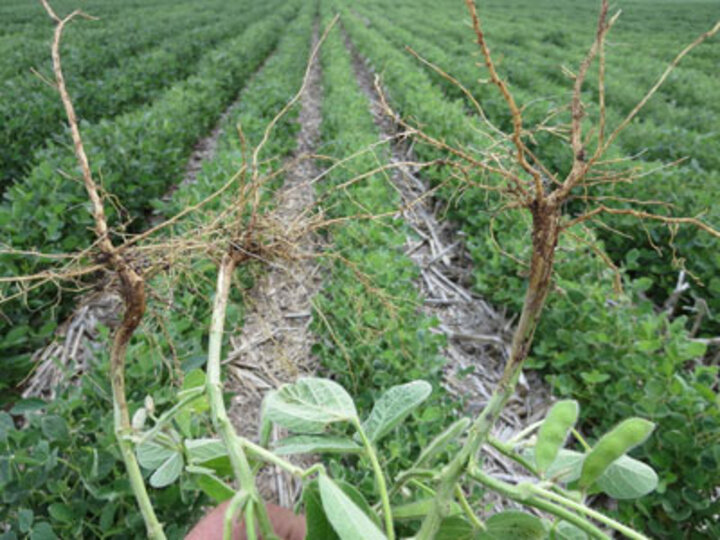August 29, 2013
If you notice areas of your soybean field aren’t producing as well as you would expect, dig up some roots. Poorly nodulated roots may mean these plants aren’t getting the nutrients they need to produce top yields.

Figure 1. Well nodulated soybean roots. (Photos by Bob Klein)

Figure 2. Soybean roots without any nodules to capture nitrogen.
On average, a soybean crop needs 315 lb N per acre, about 60% of which (190 lb) goes to seed production and 40% (125 lb) goes to stover and roots. In most cases all of this need can be supplied from the environment and additional nitrogen isn’t necessary. (In sandy or low organic soils or for yields over 70 bu/ac additional nitrogen may be recommended.)
Soybeans fix nitrogen from the atmosphere when nitrogen-fixing rhizobia bacteria are present in the soil. Nitrogen fixation is a result of the symbiotic relationship between rhizobia and the soybean plant and is evident in nodules on soybean plant roots. Most studies show that btween 50% and 60% of the nitrogen is from N fixation.
A well nodulated plant should have five to seven nodules on the primary root (Figure 1).
Checking for nodulation now can help you assess your field and make adjustments for the next crop; however, checking as early as two weeks after emergence allows you time to apply nitrogen during the season if plants are not developing nodules. (The best time to apply nitrogen in soybean is between flowering and pod fill.)
Inoculating Soybean Seed
The least expensive way to supply nitrogen to soybean is by inoculating the seed at planting.
Research in Michigan on new ground where soybeans had not been grown showed as much as a 45% yield increase for soybeans that had been inoculated compared to those that hadn't. Michigan soils generally have higher organic matter and greater mineralization; Nebraska growers might see an even higher difference. (See Michigan State University article, Soybean Seed Applied Inoculation.)
For fields where soybean has not been grown previously, inoculation is essential. For such fields, a soil-applied inoculant may provide greater yield potential than a seed-applied inoculant. For fields where soybean has been previously grown, either a soil-applied or a seed applied inoculant is good insurance for providing adequate nitrogen for the crop.
In fields where soybeans have been grown previously, sometimes reinoculation is necessary. Figures 1 and 2 are from a field without a history of soybeans. Seed-applied inoculum was used but apparently was not applied evenly to the seed. Figure 1 shows well nodulated soybeans that look great while Figure 2 shows soybeans from just a few rows over that are not nodulated and are not nearly as productive as the well nodulated fields.
Resource
For more information on this and related topics, see Nutrient Management for Agronomic Crops in Nebraska (EC155), a 176-page comprehensive guide for Nebraska crop producers.
Robert Klein
Extension Western Nebraska Crops Specialist
